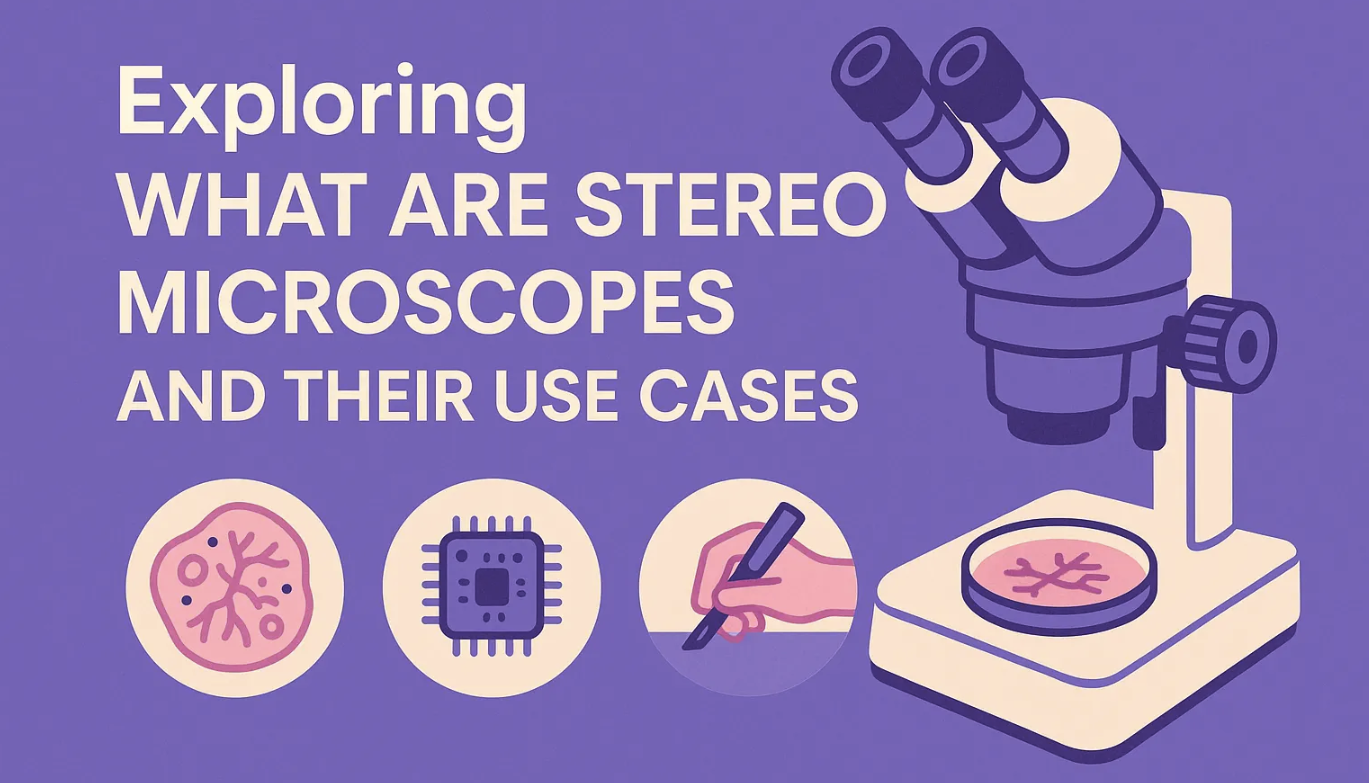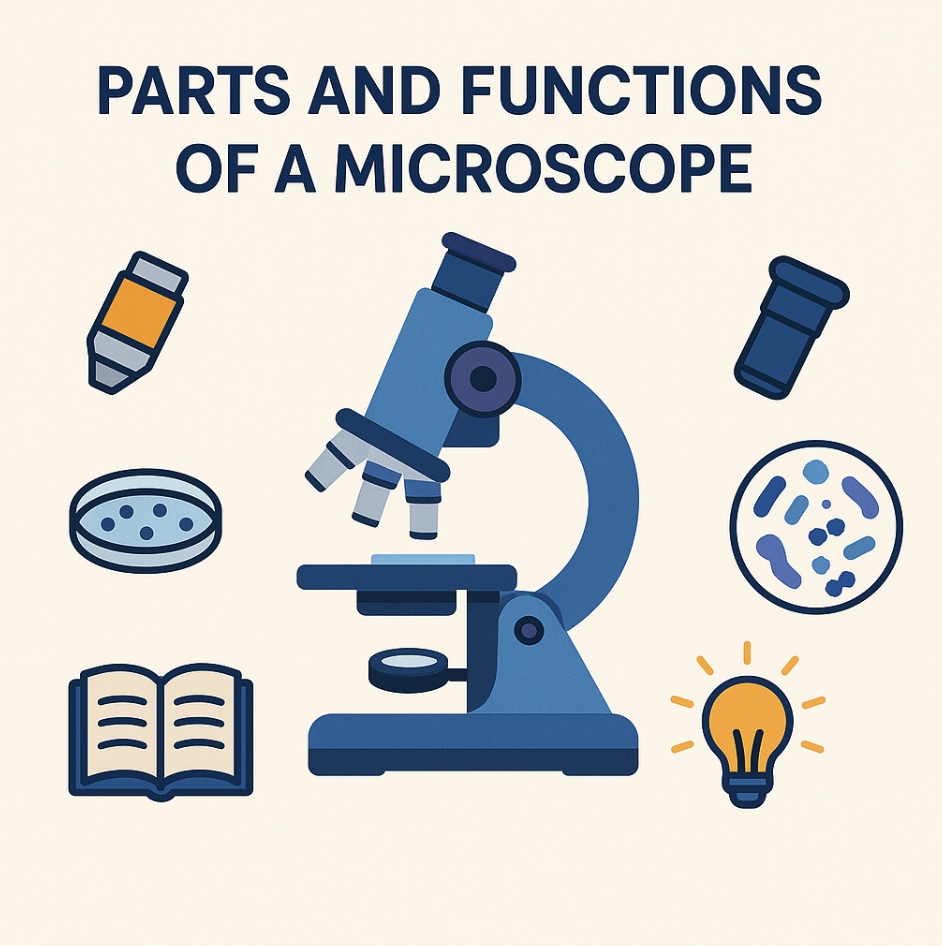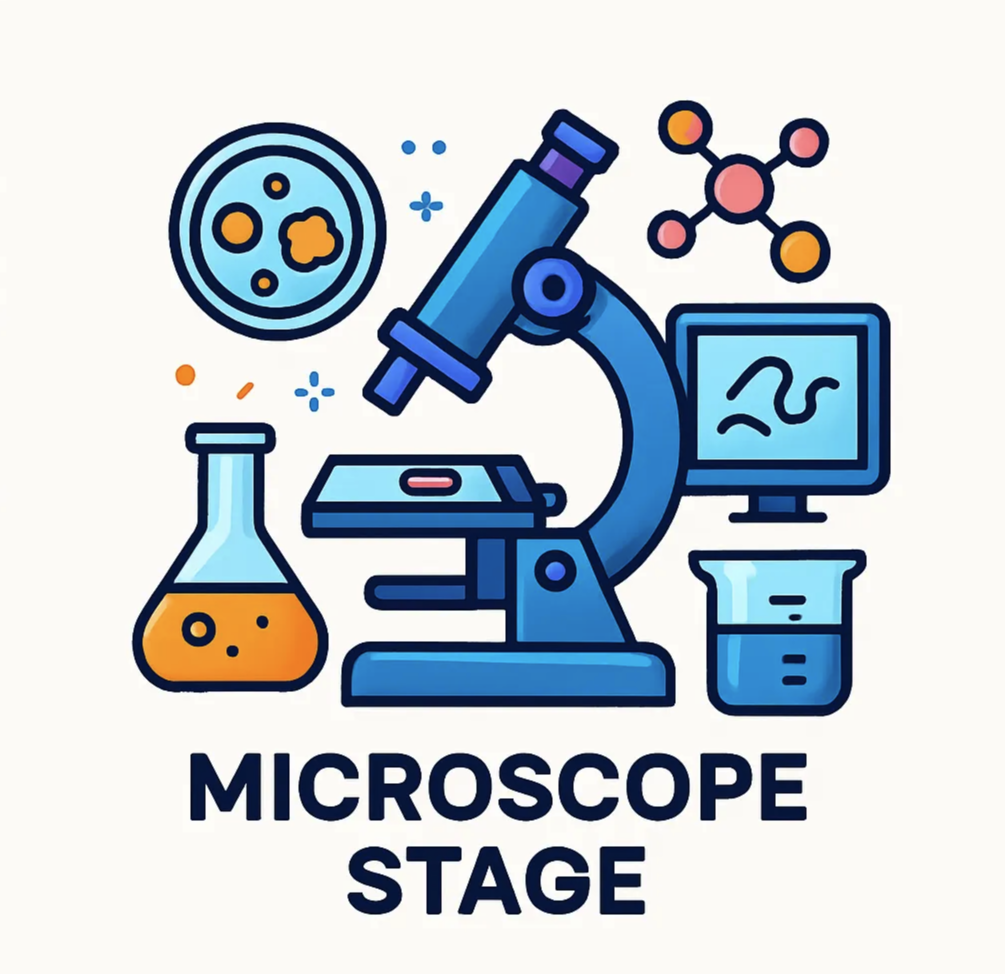
Have you ever wondered what are stereo microscopes and how they differ from the more common compound microscope? A stereo microscope offers a unique perspective by providing a three-dimensional view of specimens. This feature makes it indispensable in fields like biology, electronics, and forensics. You’ll find this microscope useful for tasks such as dissection, quality checks, and restoring art.
Due to the practical applications of stereo microscopes, there has been an increasing demand for stereo microscopes in recent years. According to Straits Research, the global stereo microscope market size is expected to grow at 6.8% CAGR from 2024 to 2032.
We will be exploring the diverse applications and benefits of stereo microscopes in this blog post, helping you understand their importance across various disciplines.
Understanding Stereo Microscopes
Have you ever gazed through a microscope and wondered about the intricate details of the world? The stereo microscope offers a unique perspective by providing a three-dimensional view of specimens. This tool proves invaluable in fields requiring depth perception, such as biology and industrial inspection.
According to a study published in Microbe Online, stereo microscopes are versatile instruments with a wide range of applications across various fields.
The unique optical design makes them indispensable for tasks that require detailed examination of solid specimens.
Definition and Basic Principles
What is a Stereo Microscope?
A stereo microscope, also known as a dissecting microscope, allows users to view objects in three dimensions. This microscope uses two separate optical paths to create a stereo effect. Each eye receives a slightly different image, providing depth perception.
The stereo microscope magnification typically ranges from 6x to 50x, making it suitable for observing larger objects like insects or plant structures.
How it Differs from Other Microscopes
The stereo microscope differs significantly from compound microscopes. Compound microscopes use a single optical path, which results in a flat image. In contrast, stereo microscopes have dual optical systems, each with its own objective lens and eyepiece.
This design allows for a three-dimensional view, which is particularly useful for examining solid objects with depth perception.
A study from Microscope World highlights that stereo microscopes are better suited for tasks requiring a detailed examination of larger specimens.
Components of a Stereo Microscope
When it comes to stereo microscopes, there are a few key parts you should know about. They magnify and illuminate your specimen so you can see it better.
The eyepieces, also known as oculars, are where you look through, and their design influences what you notice.
The objectives give the first level of magnification, making tiny details more visible.
All these parts combine to create a unique three-dimensional view that sets stereo microscopes apart.
The binocular head allows for viewing that feels natural, like how our eyes see the world. Sometimes, you might see a trinocular head for taking pictures of what you find. Or a monocular head for using one eye.
The stage holds your specimen and lets you adjust its position carefully.
Light is one key component. It lets you see details and colors. Great illumination choices, whether from above, below, or both, are key. They let you adjust for different specimens easily.
I have compiled a table showing how these parts work together in stereo microscopes:
| Component | Function | Contribution to Stereo Microscopy |
|---|---|---|
| Eyepieces | Views the specimen | Provides magnification and depth perception |
| Objectives | Gathers light and magnifies the image | Delivers the primary magnification and resolution |
| Binocular Head | Houses the eyepieces | Enables binocular viewing for natural depth and comfort |
| Stage | Supports the specimen | Allows for the precise placement and movement of specimens |
| Illumination | Provides light to the specimen | Enhances visibility, clarity, and contrast of the observed object |
Functionality
How Stereo Microscopes Work
Stereo microscopes operate by using two separate optical paths. Each path has its own objective lens and eyepiece, creating a stereo effect. The user views the specimen through both eyepieces, which provide a three-dimensional image. Such a design allows for a more natural viewing experience, similar to how the human eye perceives depth in the real world.
Advantages of Using Stereo Microscopes
Stereo microscopes offer several advantages over other types of microscopes. The three-dimensional view provides depth perception, making it easier to examine complex objects. The low magnification range is ideal for observing larger specimens without losing detail.
Advanced stereo microscopes provide high-resolution images, enhancing the quality of observations. These features make stereo microscopes a valuable tool in fields such as biology, forensics, and industrial inspection.
Applications of Stereo Microscopes
Have you ever wondered how scientists and professionals examine the intricate details of plants, animals, or even electronic components? The stereo microscope plays a crucial role in various fields, offering a three-dimensional view that enhances understanding and precision.
According to recent studies, the global stereo microscope market is experiencing significant growth due to its diverse applications.
Biological Research
Studying Plant Structures
Researchers use stereo microscopes to explore plant structures. This tool allows for detailed observation of leaves, stems, and roots. The three-dimensional view helps in understanding the complex architecture of plants.
Stereo microscopes provide clarity that aids in identifying plant diseases and abnormalities.
Observing Small Animals
Scientists often use stereo microscopes to study tiny animals. This technique provides a detailed view of their body parts. One big plus is that they can observe live organisms without causing harm. Stereo microscopes help researchers do behavioral studies with little interference.
Medical Applications
Surgical Procedures
Surgeons rely on stereo microscopes for precision during operations. Stereo microscopes offer enhanced depth perception, enabling more precise and delicate procedures. This reduces the likelihood of errors and improves patient outcomes.
Pathology
Pathologists use stereo microscopes to examine tissue samples. The three-dimensional view aids in identifying abnormalities. Stereo microscopes can also help in diagnosing diseases at an early stage. This capability supports effective treatment planning and patient care.
Industrial Uses
Electronics Inspection
Stereo microscopes play a vital role in the electronics industry. Technicians rely on these instruments to inspect components closely, identifying any defects and ensuring the overall quality of the products.
The magnified view provided by stereo microscopes is invaluable for assembling and repairing electronic devices. By utilizing these microscopes, manufacturers can maintain strict quality control standards throughout the production process.
Quality Control
Manufacturers utilize stereo microscopes for quality control processes. Inspectors examine products for flaws and inconsistencies.
The ability to see in three dimensions enhances the detection of defects. In such cases, Stereo microscopes play an important role in ensuring product reliability and customer satisfaction.
|
Application Area |
Key Benefits |
Usage Frequency |
|---|---|---|
|
Biological Research |
Detailed observation of specimens |
High |
|
Medical Applications |
Precision in procedures |
Medium |
|
Industrial Uses |
Quality assurance |
High |
|
Educational Settings |
Interactive learning |
Medium |
Educational Purposes
Have you ever wondered how educators make science come alive in the classroom? The dissecting microscope and stereo microscope play a pivotal role in educational settings. These tools provide students with a hands-on experience that enhances learning.
Classroom Demonstrations
Educators use stereo microscopes for classroom demonstrations. The three-dimensional view captivates students’ attention. Teachers can showcase the intricate details of specimens like leaves or insects – this approach fosters curiosity and engagement among students.
The dissecting microscope magnification allows for detailed observation without overwhelming students with complexity.
Laboratory Experiments
Lab experiments get a big boost from using stereo microscopes. Students can see specimens up close and learn practical skills. Moving samples around under the microscope helps them understand things better. Stereo microscopes offer a user-friendly interface, making them ideal for beginners.
The dissecting microscope provides a comfortable viewing experience, encouraging students to explore further.
Forensic Science
Have you ever watched a crime show and wondered about the tools used in investigations? Stereo microscopes play a crucial role in forensic science. These instruments help experts analyze evidence with precision.
Crime Scene Analysis
Forensic experts rely on stereo microscopes for crime scene analysis. The three-dimensional view aids in examining trace evidence. Experts can identify fibers, hair, and other minute details. Stereo microscopes enhance the accuracy of investigations, leading to more reliable conclusions.
Evidence Examination
Evidence examination becomes more effective with stereo microscopes. Forensic scientists can scrutinize documents and artifacts. The depth perception provided by these microscopes reveals hidden features. Stereo microscopes contribute to solving complex cases by uncovering critical evidence.
Art Restoration
Have you ever marveled at the restoration of ancient artworks? Stereo microscopes play an essential role in art restoration. These tools assist experts in preserving cultural heritage.
Detailed Artwork Inspection
Art restorers use stereo microscopes for detailed artwork inspection. The three-dimensional view reveals the texture and layers of paintings. Experts can assess the condition of artworks without causing damage.
Stereo microscopes provide clarity that aids in identifying areas requiring restoration.
Restoration Processes
Restoration processes benefit from the precision of stereo microscopes. Experts can apply treatments with accuracy, ensuring the integrity of the artwork. The dissecting microscope allows for careful manipulation of delicate materials.
Stereo microscopes support the meticulous work required in art conservation.
Entomology
Have you ever been fascinated by the intricate world of insects? Stereo microscopes offer an essential tool for entomologists. These devices provide a three-dimensional view, allowing detailed examination of insect anatomy and behavior.
Insect Study
Entomologists use stereo microscopes to study various insect species. The three-dimensional view enables researchers to observe anatomical features with precision.
This perspective aids in understanding insect physiology and behavior. Researchers can examine live specimens without causing harm, enhancing the study of natural behaviors.
Specimen Collection
Stereo microscopes are great for collecting and identifying insect specimens. They let you see tiny details, which helps tell similar species apart. This tool is key for accurate classification and documentation. Entomologists use these microscopes for both fieldwork and lab analysis.
Jewelry and Watchmaking
Have you ever wondered how jewelers achieve such precision in their work? Stereo microscopes play a crucial role in the jewelry and watchmaking industries.
These tools provide clarity and accuracy, essential for delicate tasks.
Precision Work
Jewelers use stereo microscopes for tasks that require extreme precision. The three-dimensional view allows for meticulous inspection and manipulation of small components.
Craftsmen can set stones and assemble intricate pieces with confidence. The microscope enhances the quality and craftsmanship of jewelry and watches.
Quality Assessment
Quality assessment in jewelry and watchmaking relies on stereo microscopes. Inspectors examine products for flaws and inconsistencies. The ability to see in three dimensions ensures thorough evaluation.
This process maintains high standards and customer satisfaction.
|
Industry |
Key Benefits |
Usage Frequency |
|---|---|---|
|
Entomology |
Detailed insect observation |
High |
|
Jewelry Making |
Precision in craftsmanship |
Medium |
|
Watchmaking |
Quality assurance |
Medium |
Choosing the Right Stereo Microscope
Have you ever faced the challenge of selecting the perfect stereo microscope for your needs? The choice can be daunting with so many options available. The right decision depends on understanding specific requirements and constraints.
Let’s explore the factors to consider and some product recommendations.
Factors to Consider
Magnification Needs
Magnification is a crucial factor when choosing a stereo microscope.
Different tasks require varying levels of magnification. For example, forensic scientists often need high magnification to examine gunshot residue or document details. Entomologists may require lower magnification for studying insect anatomy.
Consider the specific tasks and select a microscope that meets those magnification needs. A stereo zoom microscope offers flexibility with adjustable magnification levels.
Budget Constraints
Budget plays a significant role in the decision-making process. High-end models offer advanced features but come with a hefty price tag. Entry-level options provide basic functionality at a more affordable cost.
Determine the budget and prioritize features accordingly.
Investing in a quality microscope ensures durability and better performance.
The York Microscope Company offers a range of options to suit different budgets.
Product Recommendations
Entry-Level Options
For beginners or those on a tight budget, entry-level microscopes provide a good starting point.
These models offer essential features without breaking the bank. The Amscope microscope provides several affordable options with reliable performance. Consider models with fixed magnification for straightforward tasks.
Entry-level microscopes are ideal for educational purposes or hobbyists.
Advanced Models
Advanced models cater to professionals requiring precision and versatility. These microscopes feature superior optics and enhanced functionality.
The York Microscope Company offers advanced models with stereo zoom capabilities. These microscopes allow for detailed examination of complex specimens.
Professionals in fields like forensics or art restoration benefit from these high-quality instruments.
|
Model Type |
Key Features |
Ideal For |
|---|---|---|
|
Entry-Level |
Fixed magnification, affordable |
Education, Hobbyists |
|
Advanced |
Stereo zoom, superior optics |
Professionals, Forensics |
|
Budget-Friendly |
Basic functionality, durable |
Beginners, Students |
|
High-End |
Enhanced features, precision |
Experts, Researchers |
Choosing the right stereo microscope involves careful consideration of magnification needs and budget constraints. Whether opting for an entry-level model or an advanced one, the right choice enhances the ability to perform tasks effectively.
I put together a table to help you compare some key aspects of a few popular brands:
| Manufacturer | Magnification Range | Optical Quality | Ergonomics | Additional Features |
|---|---|---|---|---|
| Leica | 10x – 80x | High | User-friendly | Integrated camera systems |
| Zeiss | 8x – 50x | Superior | Advanced ergonomic designs | Modular options |
| Nikon | 5x – 70x | Excellent | Comfortable handling | Streamlined integration with software |
| Olympus | 7x – 60x | Very Good | Ergonomic for extended use | Wide accessory range |
| Meiji | 7.5x – 75x | Good | Functional design | Cost-effective solutions |
Owning a stereo microscope that fits your exact needs and brand preferences is non-negotiable. The right microscope will open up a world of discovery. Remember, your microscope is more than a tool—it’s a gateway to exploration.
Frequently Asked Questions
What is the difference between a stereo microscope and a compound microscope?
A stereo microscope provides a three-dimensional view, while a compound microscope offers a flat image.
How does a stereo zoom microscope work?
A stereo zoom microscope allows users to adjust magnification levels seamlessly, providing flexibility for various observations.
Why is depth perception important in stereo microscopy?
Depth perception enables detailed examination of solid objects, crucial for tasks like dissection and inspection.
What industries benefit most from using stereo microscopes?
Industries such as forensics, biology, and electronics heavily rely on stereo microscopes for precise observations.
Can a beginner use an advanced stereo microscope?
Yes, but beginners may find entry-level models more user-friendly and suitable for learning.
All in All
Stereo microscopes offer a unique perspective with their three-dimensional viewing capabilities. These tools excel in fields like biology, forensics, and art restoration. The ability to observe larger specimens with depth perception sets stereo microscopes apart from compound microscopes. This versatility makes them indispensable in research and industry.
Exploring stereo microscopes opens doors to detailed observation and precision work. Consider the specific needs and applications when choosing a microscope model.


